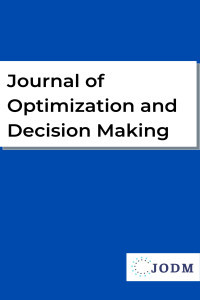Adequate compensation of DSTATCOM-based FGS for mitigating the impact of source disturbances in radial power systems
Adequate compensation of DSTATCOM-based FGS for mitigating the impact of source disturbances in radial power systems
Electrical power systems are often exposed to disturbances due to various factors (internal and external). One of these disturbances is source voltage disturbance. The source voltage sags and swells, significantly affecting sensitive loads and the rest of the system's equipment, causing them to work less well or even break down. Because of this, the effects of these disturbances on the power system should be lessened. One of the most effective solutions is to employ modern power electronics technologies such as Distribution Static Synchronous Compensator (D-STATCOM) as one of the custom power devices. Conventional PI controllers are commonly used in D-STATCOM but are not adaptive to large disturbances, which can lead to significant performance degradation. Also, the tuning methods of their parameters are tedious and time consumed. In this work, a fuzzy gain scheduled (FGS) controller integrated with PI parameters was used to provide adaptive performance in a wide range of source voltage disturbances for a radial power system. The optimal parameters were found by the response optimizer tool. Simulation of the system operation was carried out using MATLAB/Simulink software. The simulation results showed adaptive performance and superiority in response speed and overshoot value in the fuzzy control unit compared to the traditional PI units.
___
- Abdelsalam, Abdelazeem A., Sherif S. M. Ghoneim, and Ahmed A. Salem. 2022. “An Efficient Compensation of Modified DSTATCOM for Improving Microgrid Operation.” Alexandria Engineering Journal 61(7):5501–16. doi: 10.1016/j.aej.2021.10.061.
- Adnan, Hasan, and Ahmaed Alsammak. 2020. “A Comparison Study of the Most Important Types of the Flexible Alternating Current Transmission Systems(FACTs).” Al-Rafidain Engineering Journal (AREJ) 25(1):49–55. doi: 10.33899/rengj.2020.126854.1027.
- Arya, Sabha Raj, Mittal M. Patel, Sayed Javed Alam, Jayadeep Srikakolapu, and Ashutosh K. Giri. 2020. “Phase Lock Loop–Based Algorithms for DSTATCOM to Mitigate Load Created Power Quality Problems.” International Transactions on Electrical Energy Systems 30(1):1–26. doi: 10.1002/2050-7038.12161.
- Bapaiah, P. 2013. “Power Quality Improvement by Using DSTATCOM.” International Journal of Emerging Trends in Electrical and Electronics 2(4):1–12.
- Van den Broeck, Giel, Jeroen Stuyts, and Johan Driesen. 2018. “A Critical Review of Power Quality Standards and Definitions Applied to DC Microgrids.” Applied Energy 229(July):281–88. doi: 10.1016/j.apenergy.2018.07.058.
- Danalakshmi, D., Srinivas Bugata, and J. Kohila. 2019. “A Control Strategy on Power Quality Improvement in Consumer Side Using Custom Power Device.” Indonesian Journal of Electrical Engineering and Computer Science 15(1):80–87. doi: 10.11591/ijeecs.v15.i1.pp80-87.
- Eltamaly, A. M., Y. S. Mohamed, A. H. M. El-Sayed, A. N. A. Elghaffar, and A. G. Abo-Khalil. 2021. “DSTATCOM for Distribution Network Compensation Linked with Wind Generation.” Pp. 87–107 in Control and Operation of Grid-Connected Wind Energy Systems. Springer-Cham.
- Gawande, S. P., S. Khan, and M. R. Ramteke. 2013. “Design Consideration for Configuration, Topology & Control Schemes of DSTATCOM Implemented on Distribution Systems.” Lecture Notes on Information Theory 1(3):89– 94. doi: 10.12720/lnit.1.3.89-94.
- Gupta, G., W. Fritz, and M. T. E. Kahn. 2017. “A Comprehensive Review of DSTATCOM: Control and Compensation Strategies.” International Journal of Applied Engineering Research 12(12):3387–93.
- Al juboori, Mohammad, Yousif Al-Younus, and Mohammed Ali Alrawe. 2022. “Impact Study of Unequal Voltages of Power Plants (Generators).” Al-Rafidain Engineering Journal (AREJ) 27(2):110–16. doi: 10.33899/rengj.2022.134000.1176.
- Kumar, Pradeep, Niranjan Kumar, and A. K. Akella. 2014. “A Simulation Based Case Study for Control of DSTATCOM.” ISA Transactions 53(3):767–75. doi: 10.1016/j.isatra.2013.11.008.
- Latran, Mohammed Barghi, Ahmet Teke, and Yeliz Yoldaş. 2015. “Mitigation of Power Quality Problems Using Distribution Static Synchronous Compensator: A Comprehensive Review.” IET Power Electronics 8(7):1312–28. doi: 10.1049/iet-pel.2014.0531.
- Mararakanye, Ndamulelo, and Bernard Bekker. 2019. “Renewable Energy Integration Impacts within the Context of Generator Type, Penetration Level and Grid Characteristics.” Renewable and Sustainable Energy Reviews 108(October 2018):441–51. doi: 10.1016/j.rser.2019.03.045.
- Masdi, Hendri, Norman Mariun, S. M. Bashi, Azah Mohamed, and Sallehhudin Yusuf. 2004. “Design o f a Prototype D-Statcom for Voltage Sag Mitigation.” Pp. 112–27 in Proceedings. National Power and Energy Conference, 2004. Kuala Lumpur, Malaysia: IEEE.
- Naderi, Yahya, Seyed Hossein Hosseini, Saeid Ghassem Zadeh, Behnam Mohammadi-Ivatloo, Juan C. Vasquez,and Josep M. Guerrero. 2018. “An Overview of Power Quality Enhancement Techniques Applied to Distributed Generation in Electrical Distribution Networks.” Renewable and Sustainable Energy Reviews 93(May 2017):201–14. doi: 10.1016/j.rser.2018.05.013.
- Nguyen, Huu Vinh, Hung Nguyen, and Kim Hung Le. 2020. ANFIS and Fuzzy Tuning of PID Controller for STATCOM to Enhance Power Quality in Multi-Machine System under Large Disturbance. Vol. 554. Springer International Publishing.
- Qasim, Ahmed Yahyia, Ahmed Nasser B. Alsammak, and Fadhil R. Tahir. 2022. “Optimization of Power Quality Using the Unified Power Quality Conditioner ( UPQC ) with Unbalanced Loads.” Al-Rafidain Engineering Journal (AREJ) 27(2):101–9. doi: 10.33899/rengj.2022.133962.1175.
- Shahgholian, Ghazanfar, and Zahra Azimi. 2016. “Analysis and Design of a DSTATCOM Based on Sliding Mode Control Strategy for Improvement of Voltage Sag in Distribution Systems.” Electronics (Switzerland) 5(3). doi: 10.3390/electronics5030041.
- Yousif, Sabah, and Saad Mohammed. 2021. “Reactive Power Control Using STATCOM for Power System Voltage Improvement.” Al-Rafidain Engineering Journal (AREJ) 26(2):124–31. doi: 10.33899/rengj.2021.128914.1070.
- Başlangıç: 2022
- Yayıncı: Ankara Yıldırım Beyazıt Üniversitesi
Sayıdaki Diğer Makaleler
DESIGN AND IMPLEMENTATION WIRELESS SENSORS NETWORK FOR MONITORING APPLICATIONS USING ARDUINO
Selin GÜNDOĞMUŞ, Ahmet KARAARSLAN
Calibration of flow equations through regulators using computational fluid dynamics CFD modelling
Harmonics elimination of seven phase uncontrolled rectifiers driving dc motor
Simulation study for Changing some roundabouts in Karbala government into signalized roundabouts
Hussein ALI EWADH, Ali FADHLALLAH, Raıd R.A.ALMUHANNA
Ahmed ALHATTAB, Ahmed Nasser B. ALSAMMAK, Hasan A. MOHAMMED
DQ Model of PMSG with The Most Proficient Dynamic Analysis in Standalone Grid
